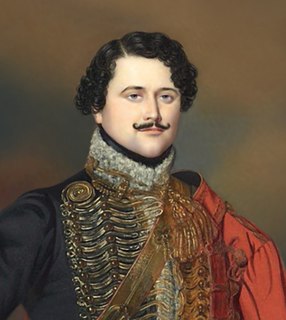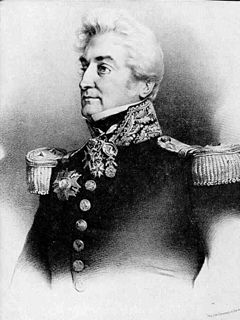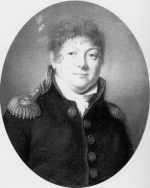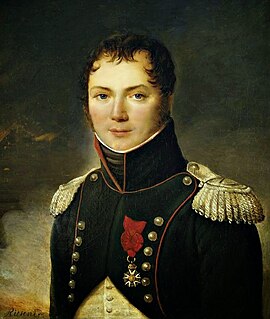Life
Radet was born at Stenay in 1762.
He joined the Régiment de La Sarre as a soldier on 4 April 1780. He was promoted to corporal on 20 March 1781, and sergeant on 26 April 1782. Dismissed on 12 October 1786, he became a constabulary's rider on 30 November of the same year.
He was appointed as a general of brigade in 1800 by Napoleon Bonaparte, who gave him the chief command of all the Gendarmerie (armed police.) In 1809 he was ordered to Rome. In July of that year he arrested the Pope Pius VII in his palace and conducted him to Florence. He received the title of baron (1809), and became a general of division in 1813.
In June 1815 he was appointed Grand Provost of the Gendarmerie (i.e. military police) accompanying the French army in Belgium during the Waterloo Campaign. [2] He was present at Ligny and at the Battle of Waterloo itself, where in the evening of 18 June he was wounded. [3] During the retreat he rode, while bleeding, in the company of Napoleon as far as Charleroi, before proceeding to Beaumont, where he attempted to rally those fleeing and stem the rout. [4] At Maubeuge and Avesnes on the 19th he issued orders to the gendarmes to start arresting the fugitives in an attempt to reconstitute the army and restore discipline. [5] At Laon on 20 June he again met the Emperor, who soon proceeded to Paris, where Radet soon followed, having been granted leave to rest and heal his wounds. While Radet was in Paris Napoleon abdicated for the second time. [6]
Upon the return of the Bourbons he was imprisoned in the citadel at Besançon on 28 June 1816, but on 24 December 1818 a royal decision granted him remission on the rest of his sentence on 24 December 1818. Allowed to retire on 1 December 1819, he died at Varennes on 27 September 1825.

The Napoleonic era is a period in the history of France and Europe. It is generally classified as including the fourth and final stage of the French Revolution, the first being the National Assembly, the second being the Legislative Assembly, and the third being the Directory. The Napoleonic era begins roughly with Napoleon Bonaparte's coup d'état, overthrowing the Directory, establishing the French Consulate, and ends during the Hundred Days and his defeat at the Battle of Waterloo. The Congress of Vienna soon set out to restore Europe to pre-French Revolution days. Napoleon brought political stability to a land torn by revolution and war. He made peace with the Roman Catholic Church and reversed the most radical religious policies of the Convention. In 1804 Napoleon promulgated the Civil Code, a revised body of civil law, which also helped stabilize French society. The Civil Code affirmed the political and legal equality of all adult men and established a merit-based society in which individuals advanced in education and employment because of talent rather than birth or social standing. The Civil Code confirmed many of the moderate revolutionary policies of the National Assembly but retracted measures passed by the more radical Convention. The code restored patriarchal authority in the family, for example, by making women and children subservient to male heads of households.

Jean-Baptiste Antoine Marcelin Marbot, known as Marcellin Marbot, was a French general, famous for his memoirs depicting the Napoleonic age of warfare. He belongs to a family that has distinguished itself particularly in the career of arms, giving three generals to France in less than 50 years. His elder brother, Antoine Adolphe Marcelin Marbot, was also a military man of some note.

General Claude-Étienne Michel, an officer in Napoleon's army, was second in command of the Chasseur Division of the Guard and commander of its Brigade of Middle Guard. He may be the officer who uttered the words often attributed to Pierre Cambronne "La Garde meurt et ne se rend pas" "The Guard dies, and does not surrender".

Emmanuel de Grouchy, 2nd Marquis of Grouchy was a French general and Marshal of the Empire.

Count Joseph Lagrange was a French soldier who rose through the ranks and gained promotion to the rank of general officer during the French Revolutionary Wars, subsequently pursuing a successful career during the Napoleonic Wars and winning promotion to the top military rank of General of Division. His name is inscribed on the west side of the arc de triomphe de l'Étoile. He later became a politician in Gers department – in its capital of Auch there is a portrait of him in the town museum and the gendarmerie barracks was named after him in January 2002.

David Hendrik, Baron Chassé was a Dutch soldier who fought both for and against Napoleon. He commanded the Third Netherlands Division that intervened at a crucial moment in the Battle of Waterloo. In 1830 he bombarded the city of Antwerp as commander of Antwerp Citadel during the Belgian Revolution.

Jean Maximilien Lamarque was a French commander during the Napoleonic Wars who later became a member of the French Parliament. Lamarque served with distinction in many of Napoleon's campaigns. He was particularly noted for his capture of Capri from the British, and for his defeat of Royalist forces in the Vendée in 1815. The latter campaign received great praise from Napoleon, who said Lamarque had "performed wonders, and even surpassed my hopes".

Jacques Gervais, baron Subervie was a French general and politician.

Marie-François Auguste de Caffarelli du Falga was a French général de division of Italian descent. Two of his brothers were also generals. His name is inscribed on the south side of the Arc de Triomphe.

Antoine Jay was a French writer, journalist, historian and politician.

Sextius Alexandre François de Miollis was a French military officer serving in the American Revolutionary War, the French Revolutionary Wars, and the Napoleonic Wars.

Jean Augustin Ernouf was a French general and colonial administrator of the Revolutionary and Napoleonic wars. He demonstrated moderate abilities as a combat commander; his real strength lay in his organizational and logistical talents. He held several posts as chief-of-staff and in military administration.

Pierre David Édouard de Colbert-Chabanais was a general of the French Revolutionary Wars and Napoleonic Wars, noted for his unbreakable loyalty to Napoleon I.

Nicolas Léonard Beker or Nicolas Léonard Becker or Nicolas Léonard Bagert, born 18 January 1770 – died 18 November 1840, joined the French army as a dragoon before the French Revolutionary Wars and rose in rank to become a general officer. In 1800 he married the sister of Louis Desaix, who was killed at the Battle of Marengo. He led an infantry brigade in the 1805 campaign and commanded a dragoon division in 1806 and 1807. In 1809 he became chief of staff to Marshal André Masséna but ran afoul of Emperor Napoleon and was banished from the army for several years.
Antony Béraud, real name Antoine-Nicolas Béraud, was a French military, chansonnier, writer, poet, historian and playwright.
Guillaume François d'Aigremont was a French general de brigade.

Charles Claude Jacquinot commanded a French cavalry division at the Battle of Waterloo in 1815. He joined a volunteer battalion in 1791 and transferred to a light cavalry regiment as a junior officer in 1793. He earned promotion to squadron commander and was acting commander of his regiment at Hohenlinden in 1800. After serving in a staff position at Austerlitz in 1805, he led a light cavalry regiment at Jena in 1806. Promoted to general of brigade he led his horsemen at Abensberg, Raab and Wagram in 1809. During the French invasion of Russia he fought at Ostrovno, Smolensk and Borodino in 1812. During the 1813 German Campaign he led a cavalry brigade at Dennewitz and Leipzig. After being appointed general of division he fought at Second Bar-sur-Aube and Saint-Dizier in 1814. During the Hundred Days he rallied to Napoleon and led a light cavalry division in the Waterloo campaign. After 15 years of inactivity, he was restored to favor in the 1830s. Thereafter he held a number of commands and was appointed to the Chamber of Peers. His surname is one of the names inscribed under the Arc de Triomphe, on Column 20.

Antoine Simon Durrieu was a French General and politician. He was born on 20 July 1775 in Grenade-sur-l'Adour (Landes) and died on 7 April 1862 in Saint-Sever (Landes).
This page is based on this
Wikipedia article Text is available under the
CC BY-SA 4.0 license; additional terms may apply.
Images, videos and audio are available under their respective licenses.
















